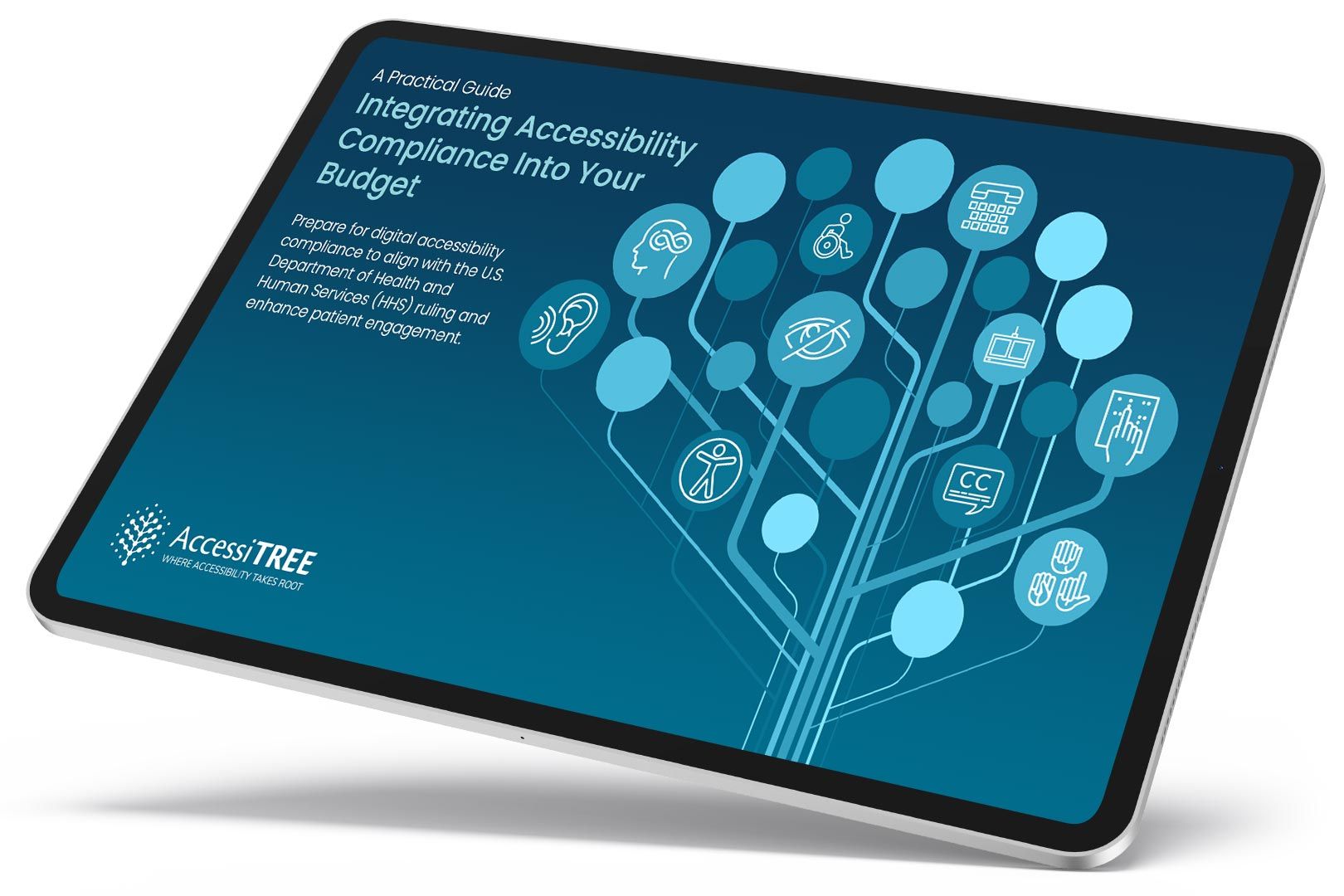
The Cost of Non-Compliance
Digital accessibility is no longer just a “nice-to-have.” With evolving standards and new regulations, it has become an essential aspect of running a compliant and responsible business, especially for organizations with an online presence. Despite these changes, many businesses continue to underestimate the true cost of failing to meet digital accessibility standards. This article explores the legal, financial, and reputational risks associated with non-compliance and explains why prioritizing digital accessibility is not only a legal requirement but a smart business decision.
Legal Risks: The Growing Threat of Accessibility Lawsuits
In recent years, digital accessibility lawsuits have been on the rise. The introduction of new standards and regulations, such as the updated Web Content Accessibility Guidelines (WCAG) 2.2 and recent rulings from the U.S. Department of Health and Human Services (HHS), has made it clear that the legal landscape around digital accessibility is tightening. For many organizations, this means that ignoring these standards could lead to substantial legal liabilities.
Under laws such as the Americans with Disabilities Act (ADA), Section 504 of the Rehabilitation Act of 1973, and more recent state-level legislation, businesses are required to ensure their websites and digital content are accessible to individuals with disabilities. Non-compliance can lead to lawsuits, which are often expensive to settle, even if the company wins the case.
For example, a lawsuit may not only involve legal fees and potential settlements, but it may also result in mandated remediation of inaccessible content—a process that can be significantly more expensive when done reactively. The costs associated with defending a case can reach tens of thousands of dollars, while settlements can range from a few thousand to hundreds of thousands of dollars, depending on the scope of the non-compliance.
Financial Risks: Hidden Costs That Can Impact Your Bottom Line
The financial risks tied to non-compliance go beyond lawsuits and legal fees. Organizations that fail to prioritize accessibility may find themselves facing significant hidden costs. Here are some of the ways non-compliance can hurt your bottom line:
- Remediation Costs: Retrofitting accessibility features after a lawsuit or complaint is often much more costly than incorporating accessibility from the start. A proactive approach to digital accessibility can minimize these expenses and ensure a smoother integration of compliance standards.
- Penalties and Fines: Non-compliance with accessibility regulations can also lead to fines or penalties from regulatory bodies. For instance, under the new HHS ruling, healthcare providers who do not meet digital accessibility standards could face steep fines and potential loss of federal funding.
- Lost Revenue Opportunities: Inaccessible websites can limit a business’s ability to reach a wider audience, including customers with disabilities who may need accessible content to engage with your brand. This can result in lost sales, reduced market share, and lower customer retention rates.
- Increased Development Costs: Reactively addressing accessibility issues often means making last-minute changes to digital products or website design, which can disrupt development cycles, delay product launches, and require more resources.
- Insurance Costs: Companies with a history of accessibility-related lawsuits or settlements may face increased insurance premiums, particularly for liability insurance policies. Insurers may view these organizations as higher risk, leading to increased coverage costs.
Reputational Risks: The Impact on Brand Image
A company’s reputation can be significantly impacted by its stance on digital accessibility. Ignoring accessibility standards can portray a business as neglectful of inclusivity, leading to negative publicity and damaging its brand image. For many customers, especially those who value corporate social responsibility, this can be a deal-breaker.
- Customer Trust and Loyalty: When people with disabilities encounter barriers on your website, it sends a message that they are not valued as customers. This can erode trust and loyalty, not just among affected users but also within the broader community.
- Public Relations Fallout: If a business becomes the subject of an accessibility-related lawsuit, the negative attention can extend beyond the courtroom. Bad press can tarnish the brand’s reputation, with the company being perceived as non-inclusive or discriminatory. This can have long-term effects on customer perception and brand equity.
- Social Media Backlash: News spreads quickly on social media. A single complaint about an inaccessible website can lead to widespread criticism, putting pressure on the company to take action. Social media users often rally behind issues related to social justice, including accessibility, making it easy for a minor incident to become a major PR crisis.
Regulatory Standards Are Evolving—Is Your Organization Ready?
The recent HHS ruling and other updates to accessibility standards reflect an ongoing shift towards stricter regulations. With digital accessibility gaining momentum, compliance is not only necessary for legal reasons but also as a means of future-proofing your business.
- Evolving WCAG Guidelines: WCAG guidelines are continuously being updated to address the evolving needs of users with disabilities. The latest version, WCAG 2.2, introduces new criteria that organizations must meet, such as enhancements to keyboard navigation and focus appearance, to remain compliant.
- Section 504 Deadlines: Healthcare providers, in particular, should be aware of Section 504 deadlines and requirements. As more deadlines approach, the pressure to comply will only increase, making it crucial to address accessibility proactively rather than reactively.
- Sector-Specific Regulations: In addition to federal regulations, some industries face specific accessibility requirements. For example, healthcare, education, and government sectors often have additional compliance rules. Staying informed about these requirements is essential to avoid penalties and ensure inclusivity.
The Business Case for Prioritizing Digital Accessibility
Meeting accessibility standards is not just about avoiding legal and financial consequences—it also presents several business benefits. Here are some reasons why digital accessibility should be a priority:
- Expand Your Customer Base: Ensuring your digital content is accessible opens up your business to a wider audience, including the estimated 61 million adults in the U.S. who live with a disability. Accessible websites can attract more traffic, improve customer satisfaction, and increase conversions.
- Improve SEO and Website Performance: Many accessibility practices align with search engine optimization (SEO) best practices, such as using descriptive alt text for images and ensuring proper heading structure. By making your website accessible, you can also boost its search engine ranking and overall user experience.
- Enhance Usability for All Users: Accessibility improvements often benefit all users, not just those with disabilities. For example, keyboard navigation enhancements and color contrast adjustments can make it easier for everyone to interact with your website, leading to a more positive user experience.
- Demonstrate Corporate Social Responsibility: Companies that prioritize accessibility show a commitment to inclusivity and social responsibility, which can resonate with customers, partners, and employees. This can lead to stronger brand loyalty, better recruitment, and improved stakeholder relationships.
Proactive Steps to Ensure Compliance
To avoid the costs of non-compliance and maximize the benefits of accessibility, businesses should take proactive steps toward digital accessibility:
- Conduct an Accessibility Audit: Regularly auditing your website against the latest WCAG standards can help identify areas that need improvement. This audit should be comprehensive, covering both content and technical aspects of your digital properties.
- Incorporate Accessibility into Development Workflows: Make accessibility a standard part of your design and development processes. This includes training your team on accessibility best practices, using accessible design patterns, and testing digital products for accessibility throughout their lifecycle.
- Partner with Accessibility Experts: Working with specialists who understand digital accessibility standards can help ensure your compliance efforts are effective. Experts can provide guidance, training, and tools to implement accessibility correctly.
- Stay Informed About Regulatory Changes: Keep up with evolving accessibility regulations and guidelines to ensure ongoing compliance. This includes monitoring updates to WCAG and being aware of any new sector-specific accessibility requirements.
The risks of ignoring digital accessibility extend beyond potential legal trouble; they encompass significant financial costs, damage to reputation, and missed business opportunities. As regulations continue to evolve, the cost of non-compliance will only increase, making it essential for businesses to prioritize digital accessibility. By taking proactive steps to ensure compliance, companies can not only avoid costly pitfalls but also enhance their brand, improve customer experiences, and contribute to a more inclusive digital world.
Ensuring your digital content is accessible is not just about following the rules—it’s about doing what’s right for your business and your customers.

Need Help With Digital Accessibility?
Our team is here to guide you through the process of meeting accessibility standards. Contact us today to get started.

A practical guide for healthcare leaders navigating WCAG compliance.
